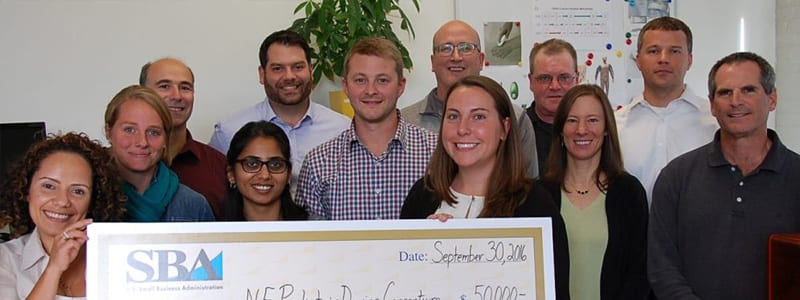How to Create A Medical Device Grant Program
Innovation or commercialization grant programs are a fantastic resource for first-time entrepreneurs learning how to overcome technical and business hurdles. At Simbex, we have extensive experience developing and implementing commercialization grant programs for NIH and FDA designed to support innovation and help get medical device and consumer health products into the hands of the patients, clinicians and caregivers who need them.

During that time, we assessed and provided feedback on over 900 medical device concepts and provided personalized in-kind services to 180 innovators, many of whom now have a product on the market, in clinical studies or have received follow on funding to further their product development. Knowing the positive impact grant programs can have on medical device innovation, here we share key learnings to consider when developing similar initiatives to support entrepreneurs.
Six Keys to an Impactful Commercialization Grant Program:
1.
Develop a Comprehensive Application Template
The success of an innovation grant program depends only in part on the accomplishments of the awardees; a well-run program provides opportunities for growth and learning at every stage of the grant cycle. Simply the process of applying can be an educational opportunity if it requires applicants to think through business and clinical as well as technical milestones, with their inherent hurdles and risks.
Consider, as we did, using a question-and-answer style application template to introduce commercialization concepts such as need and opportunity, competition, clinical workflow, regulatory and reimbursement and intellectual property. Craft questions where the answers will indicate to you the level of understanding the applicant has about the commercialization process, how far along they are and what they need to learn. Whether you are running a program for researchers contemplating entrepreneurship or for established companies, this approach will help you determine which projects are a good fit.
2.
Consider a Two-Phase Application Process
At Simbex, we employed a two-phase approach to the application cycle, requiring first a brief, non-confidential series of multiple choice and short answer questions regarding the problem the device is designed to solve, technical solution, and commercialization goals and challenges (the “abstract”), followed by the more detailed, full application. The use of an abstract increases the overall quality of the full application pool by ensuring the proposed projects fit the mission of the grant program, and ensuring the projects are in the right stage of development for the type of program.
3.
Provide High Quality and Actionable Feedback
In accordance with the educational mission of our grant programs, Simbex structured both the abstract and application review process as an opportunity for helping applicants not only improve their applications, but to understand the multiple barriers that exist to bringing new technologies to market and develop an effective commercialization strategy. The review committee provided valuable feedback for next steps, links to resources for further assistance, and advice for resubmissions.
4.
Assemble a Review Committee with a Range of Perspectives and Complementary Experiences
Medical device commercialization requires a variety of skillsets and the review panel should reflect that by representing relevant areas of technical, business, and clinical expertise. Panel range improves the quality of feedback and provides diversity of perspective. During our review committee meetings, an engineer might praise a technically feasible device concept while a clinician might point out that it was unlikely to be reimbursed. Thus, from a business perspective, it did not make sense to continue technical development until a path to market and payment were verified, providing a comprehensive commentary for the applicant to consider further.
5.
The Award Should “Move the Needle”
One metric of success of a grant program is the ability of awardees to make measurable progress, such as acquiring enough data to reach a milestone or make a critical decision, to “move the needle” in other words. When determining review criteria, the capacity of the award to move the needle should be considered alongside the quality of the application and the capabilities of the team. Will the award enable them to clear a hurdle or remove an area of risk? At Simbex, our funding awards also comprised in-kind advisement to assist their progress, thus our review process included assessing how willing a team was to working with us over a period of months to make meaningful progress on their commercialization activities.
6
Increase Impact through Target Challenges
One particularly impactful programmatic endeavor is to partner with a foundation focused on a specific area of need. In addition to the open call for proposals, our FDA-funded New England Pediatric Device Consortium (NEPDC) ran a yearly Target Challenge, partnering with a foundation to drive innovation in their area of focus. One target topic was Pediatric Apnea, in which we partnered with Graham’s Foundation for premature babies and the Nation Sleep Foundation to promote innovation and entrepreneurship in the development of apnea monitoring devices and CPAP masks for infants and children. The foundations were able to promote innovation without having to run their own grant program and, with the matching donations from the foundations, NEPDC was able to increase the impact of their own awards and services.
Continued Excellence in Commercialization Assistance
Through our federally funded grant programs, Simbex spent over a decade providing assistance and education to help innovators navigate and accelerate the challenging commercialization process. Today, along with our 21 years of expertise in medical device design and development, Simbex provides a menu of high touch, high value commercialization consulting services to assist innovators with achieving their go-to-market goals. Our structured approach to identify and mitigate risk is designed to ensure there is a product/market fit and thus a viable opportunity that maximizes the returns on the money, time, and energy innovators invest in their technology. Simbex clients are on the frontline of improving the health care we receive every day and we take tremendous pride in being a part of that journey.





